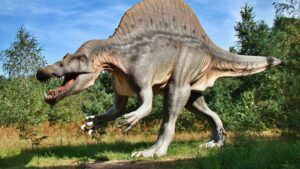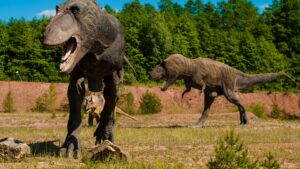In the realm of paleontology, nothing quite stirs up excitement like the discovery of a new dinosaur. The thrill intensifies when it’s a species from the ark – that colossal collection of creatures that once roamed the earth. This article delves into the fascinating world of ark dinosaur discovery, a topic that continues to captivate scientists and enthusiasts alike.
Unearthing the secrets of the past isn’t just about dusting off old bones. It’s a complex process that combines meticulous fieldwork, advanced technology, like QR code and a deep understanding of geological timelines. So, buckle up as we journey back in time, exploring the mysteries of ark dinosaurs, their existence, and their eventual extinction.
This piece promises to be a riveting ride for those who are intrigued by these prehistoric giants and the scientists who dedicate their lives to unveiling their secrets. So, let’s start this adventure into the world of ark dinosaur discovery.
Ark Dinosaur Discovery
 Unmasking the ark dinosaur discovery’s significance takes us on a journey that connects historical events, showcases unprecedented scientific breakthroughs, and broadens understanding of natural history’s grand narrative.
Unmasking the ark dinosaur discovery’s significance takes us on a journey that connects historical events, showcases unprecedented scientific breakthroughs, and broadens understanding of natural history’s grand narrative.
Embracing the importance of the ark dinosaur discovery involves understanding the meticulous process behind it. It all starts with vigilant exploration. Every artifact found at an excavation site, minor or considerable validation of an epoch long gone. Each fossil, teeming with information, gives insights into the dinosaur’s life span, diet, environment, and possible cause of extinction. For instance, teeth fossils offer insights into the dinosaur’s diet—sharp, pointed teeth were generally associated with carnivores, while flat, grinding teeth tie back to plant-eating dinosaurs.
Moreover, the presence of bones together or scattered can suggest the likelihood of a natural catastrophe that led to the dinosaurs’ demise. In stark contrast, singular bones hint towards possible predator attacks or gradual disease-related mortality in the dinosaur community. This unparalleled access to enriched data fundamentally redefines our understanding of prehistoric eras, making each ark dinosaur discovery an invaluable reservoir of knowledge.
The global impact of these discoveries is immeasurable, leaving an indelible mark on the field of paleontology. Each new discovery refines our understanding of the world’s geological timeline, from the shifting of continents to changes in climate. Scientific communities across the globe find their theories corroborated or negated with each unearthed fossil, leading to an ever-evolving field of study.
Indeed, this synergy of archaeological sleuthing and meticulous scientific analysis underscores the significance of the ark dinosaur discovery, and everyone—from school children to academics—is privileged to delve into this ancient world brought back to life.
Investigating the Site of Discovery
 Delving deeper into the realm of archaeology, this section will shed light on the hub of discovery, focusing on geological characteristics of the locale, and illuminating the excavating tools and technology that play pivotal roles in uncovering these prized artifacts. Positioned on what the world defines as prime archaeological real estate, the ark dinosaur discovery site boasts unique geological characteristics. Comprising mainly sedimentary rocks – specifically, sandstone, limestone, and shale – this area has proven fertile ground for preserving fossils. These stone types contain a history of the earth’s physical formation, capturing imprints of once-thriving flora and fauna, providing snapshots of prehistoric environments. With each layer of the site excavated, a new chapter in nature’s narrative unfolds. From the varying layers of sediment, it’s inferred that the region underwent significant ecological shifts, influenced by geological transformations like volcanic eruptions, floods, and ice ages. For the ark dinosaur discovery, it’s this preserved prehistory that paints a vivid portrait of the dino-centric epoch.
Delving deeper into the realm of archaeology, this section will shed light on the hub of discovery, focusing on geological characteristics of the locale, and illuminating the excavating tools and technology that play pivotal roles in uncovering these prized artifacts. Positioned on what the world defines as prime archaeological real estate, the ark dinosaur discovery site boasts unique geological characteristics. Comprising mainly sedimentary rocks – specifically, sandstone, limestone, and shale – this area has proven fertile ground for preserving fossils. These stone types contain a history of the earth’s physical formation, capturing imprints of once-thriving flora and fauna, providing snapshots of prehistoric environments. With each layer of the site excavated, a new chapter in nature’s narrative unfolds. From the varying layers of sediment, it’s inferred that the region underwent significant ecological shifts, influenced by geological transformations like volcanic eruptions, floods, and ice ages. For the ark dinosaur discovery, it’s this preserved prehistory that paints a vivid portrait of the dino-centric epoch.
Techniques and Technologies Used in the Excavation
 Scientific exploration marries manual labor in the meticulous process of exhuming ark dinosaur fossils. From manually shoveling to employing mechanized equipment, multiple approaches facilitate an efficient excavation whilst preserving the data-rich site.
Scientific exploration marries manual labor in the meticulous process of exhuming ark dinosaur fossils. From manually shoveling to employing mechanized equipment, multiple approaches facilitate an efficient excavation whilst preserving the data-rich site.
Consider Penetrometers, for instance. They gauge soil strength and density before excavation, determining the presence of potential obstructions like rocks, roots, etc. Leveraging Ground Penetrating Radar (GPR) enables archaeologists to visualize the subsurface, indicating where fossils might reside and helping avoid damaging these historical treasures.

